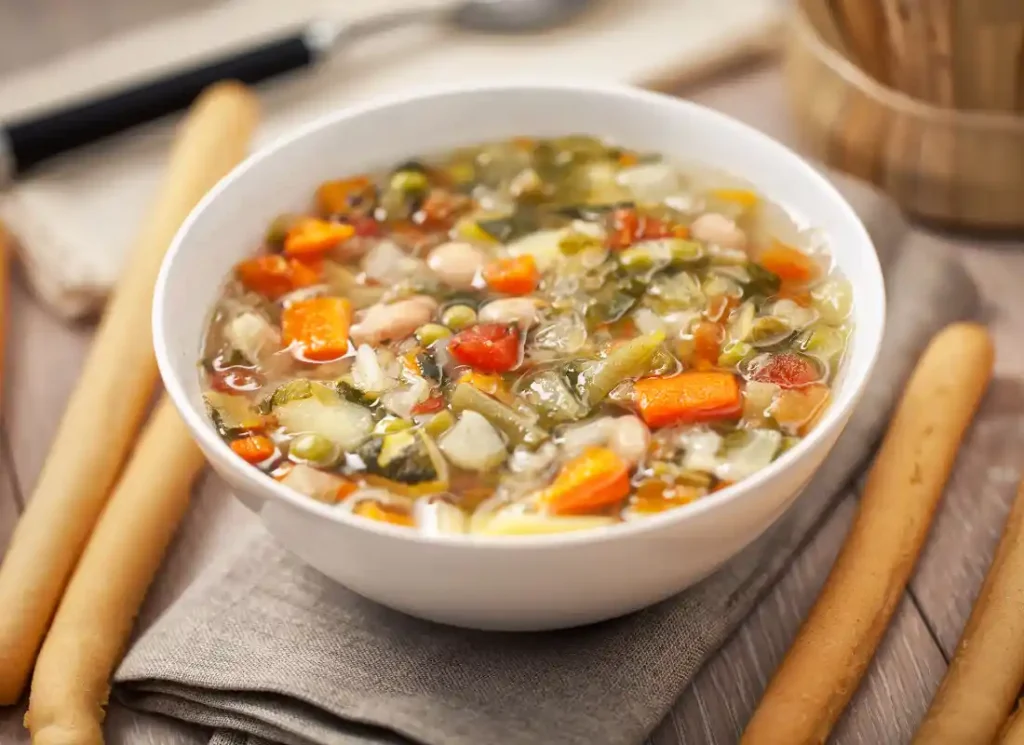I’m doing my Master’s and I am in that awful period where all the classes have finished, and I have been made responsible for my own time (who thought that that would be a good idea?). Writing assignment after assignment, I am perpetually stressed, my laptop screen has become my biggest priority and my life outside Microsoft Word is virtually non-existent. Although nourishing your brain when it’s working hard towards a degree is necessary, I have to say, cooking has taken a bit of a back seat in my schedule. With all my creativity pouring into finding endless different ways of saying ‘furthermore’, I don’t have much time to experiment once I get in front of the cooker. As a student, I am in desperate need of easy but delicious recipes, and as a Hungarian, I need to meet my weekly soup intake.
I know, I know, summer is coming. Out with cosy dinners and hearty dishes and in with beach cocktails and sunny picnics. Everybody is getting ready to leave the dark, cold, and depressing winter behind and embrace the warm joy of sunshine on your face and the coolness of ice cream on your lips. But hear me out. Firstly, I will not be taken for a fool by English weather again.
Unfortunately, living in the UK for more than half a decade has given me trust issues and while I enjoy the heat, I am also preparing myself for the rainy and cold nights that are sure to follow. Secondly, even if it’s all summer from now on, I am vehemently against the idea that soups are just for winter days or when you are ill. I mean, yes, they have magical powers when it comes to curing illness or keeping one warm, but they are also perfect for all occasions, weathers, and climates. Soups are easy, nourishing and made using only one pot. They are a great way to get your veggies in without having to wash up for hours after or getting into exceedingly complicated recipes.
No surprise that people have been eating soups for centuries and all over the world. The history of soup is almost synonymous with the history of fire and preparing food by boiling. Below, I offer you a selection of some of my favourite soups from all over the world. This list is of course subjective as I am very much soup-positive and believe that all soups are beautiful and delicious. But with all soups being equal, some are more equal (in my eyes), and these are the ones I’m sharing with you in hopes that they will also provide you with some ease and deliciousness in the harder times.
Read more from Zsófi’s Kitchen: A Complete Guide to Eastern European Food
Húsleves I Hungary
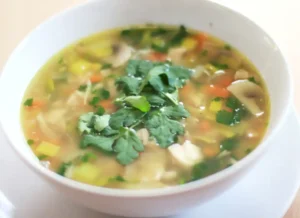
Of course, I have to start with the ultimate soup of soups for any Hungarian person, and that is Húsleves or Meat Soup. Although the dish that Hungary became internationally known for is Gulyás (another soup to nobody’s surprise), within the country itself, nothing can beat Húsleves especially if you’re hungover, tired, ill, or if it’s a Sunday. It is the soup of childhood, nostalgia, and the centrepiece of every family reunion where grandma’s cooking.
While its name is not very imaginative as it literally is a soup made from meat, the recipe makes up for this lack of creativity. It consists of tender pieces of meat that are cooked in a flavourful broth with some soup noodles and an assortment of vegetables such as carrots, parsnips, potatoes, and kohlrabi.
Both the meat and the vegetables are cooked as a whole, without slicing or dicing. This makes the preparation really easy, as you can just chuck all the ingredients in; however, it is really important that you also take them out when serving. Húsleves is always served in a big bowl full of only broth and noodle, the vegetables and meat are plated on a separate dish. Diners serve some soup for themselves from the bowl which, although has no veggies or meat, carries their flavours in the broth, and if they wish to, can add some veggies and meat separately onto their plate.
Unfortunately, as Húsleves gains its flavours mainly from the meat, it is really difficult to do it vegan or vegetarian. It is definitely the dish I miss the most from my meat-eating days, and I still longingly smell the kitchen after my mum’s prepared a big pot of Húsleves for the family, but don’t worry, I supplement it by having really fantastic vegetable soups, so it’s all good.
Read Zsófi’s Vegetarian Hungarian Recipes here
Harira I Morocco
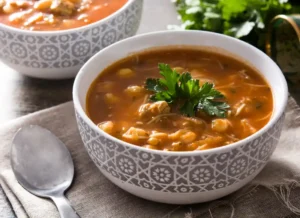
The history of this rich tomato-based soup, Harira, is intertwined with the history of Morocco where it symbolises unity and togetherness. It is often prepared during the month of Ramadan where it is served as the first dish of the iftar meal, accompanied by dates, figs, and sweet pastry, as families break their fast together over big bowls of steaming broth. Its origins themselves are deeply ingrained in that of Ramadan as it dates back to the 9th century where it was originally created to nourish people after a long day of fasting. This is reflected by its ingredients which consist of a rich variety of legumes such as lentils, fava beans, and chickpeas which are supplemented in some households by rice or vermicelli noodles to thicken the mixture.
It is a wonderfully velvety and creamy soup which is unsurprising given that the name comes from the Arabic ‘hareer’, meaning smooth. Harira, however, is not for lovers of bland food (if such people even exist) as it brings together a rich blend of herbs and spices which, depending on family recipe, can include parsley, coriander, cumin, turmeric, ginger, and even a bit of lemon zest! To chunk up the broth, some families add pieces of lamb or beef, but good news – Harira is a mostly meat-free dish and is easy to find all year round!
Caldo Verde I Portugal
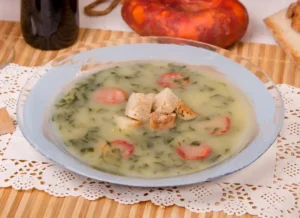
Another absolute staple, Caldo Verde, literally meaning Green Broth, is a Portuguese Green Soup originating from the Minho region in the north of Portugal. Despite its humble ingredients, it has become one of the most celebrated dishes in Portugal and beyond. Its name comes from its primary ingredient and colour-giver, couve-galega or Galician kale, a leafy green that is then chopped into thin slices and added to a broth of potatoes, onions, and garlic. It’s a simple, earthy dish, which can be prepared using ingredients you can find in your kitchen even after days of not seeing the supermarket. Its beauty lies in precisely this, its humble deliciousness that feels just as in place at the family table or at festivities as at high-end restaurants.
My obligatory note for vegans: Caldo Verde is often served with traditional Portuguese sausages like chouriço or linguiça, but if you make sure that these are taken off, you’ve got a wonderfully delicious and real authentic vegan Portuguese soup on your hands.
Tom Yum Goong I Thailand

Thailand’s favourite appetiser, Tom Yum Goong is an absolute celebration of flavours. Alongside mushrooms and prawns, the real stars of the dish are undoubtedly the herbs and spices: the zestiness of the lime juice, the lemongrass, the citrusy kaffir lime leaves, the galangal, and the subtle spiciness of the Thai chilli peppers all come together to create the iconic rich broth that has become a necessity around Thai festivities or in Thai restaurants around the world. Topped off with some coriander and Thai basil, Tom Yum Goong is ready to serve and steal hearts.
As a dish that can be traced back to the ancient kingdom of Siam, Tom Yum Goong is a staple in Thai cuisine. It has gone through many iterations throughout its history, and different regions have developed their own versions. Central Thailand, for example, prefers Tom Yum Goong Nom Khan, in which the famous broth is enriched with some coconut milk, thus blurring the lines between Tom Yum and Tom Kha. It is a creamier, heavier version, but the coconut milk also balances the heat of the original perfectly. In the South, however, people often prepare Tom Yum Goong Nam Sai instead, which is famous for its tangy and zesty flavours, achieved by adding extra fish sauce and lime juice when cooking. A vegan version can also easily be prepared if one replaces the shrimp with vegan shrimp or tofu and the fish sauce with soy sauce. Remember that most of the flavour in this dish comes from the blend of spices, and those are all vegan, so don’t be afraid to experiment!
Minestrone I Italy
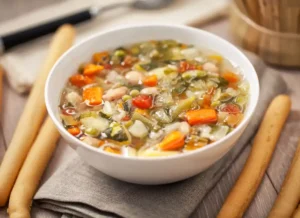
There is not one recipe for this popular Italian vegetable and legume-based soup, with each region, household, person adding their own flair. With its history dating back to the Roman times, Minestrone used to be known as a “poor man’s dish” (like all good dishes are): its origins lie in peasant cooking where the leftovers were collected at the end of the day and cooked together in a large pot as a soup. Outgrowing its humble beginnings, Minestrone is well-known and well-loved around the world today. They are often served as appetisers or as main dishes with a side of bread to dip into the rich broth.
The good news is that it is an authentically vegan dish. Minestrone traditionally features seasonal vegetables, often garlic, carrots, onions, tomatoes and carrots. These are bulked up by legumes like white or butter beans, and carbohydrates like rice or pasta. The result is a delicious and nutritious blend that is at the same time, incredibly filling – perfect for lazy days and no-nonsense cooks. A warning for the Brits: stay away from the blender when preparing minestrone! While blended soups can be absolutely fantastic, a Minestrone is only as good as a sum of its chunks. It is best when chunky and thick with all its ingredients creating a rich medley of veggies on your plate.
Miso I Japan
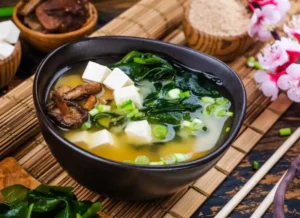
Boasting a millennium-long history in Japan, the origins of Miso soup can be traced back to 1300 years ago when Buddhists priests brought over China’s chiang, a fermented soybean paste to Japan. The Japanese then took this simple ingredient and did … magic(?) as they transformed it into what is known today as Miso soup. At the heart of Miso soup is the miso paste, a fermented blend made from soybeans, rice, and salt. This is then mixed with dashi, a flavourful stock derived from seaweed and fish sauce. The miso-dashi mixture provides the foundation to the broth to which chunks of silk tofu, wakame seaweed, and thin slices of scallions are usually added. Miso has become a staple of Japanese cuisine, accompanying most traditional Japanese meals as its deep flavours bring the umami to balance the flavours of other dishes. However, nowadays, Miso soup can also be served on its own, or made at home easily by purchasing instant miso sachets and adding hot water to the miso broth paste and the dehydrated tofu and seaweed that are usually included.

